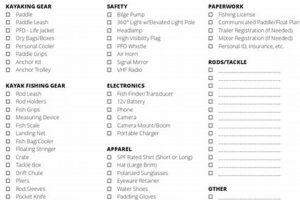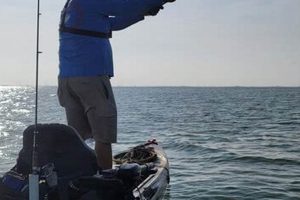Customizations made to kayaks for the purpose of enhancing angling experiences are often referred to as fishing-specific alterations. These alterations can range from simple additions like rod holders and anchor trolleys to more complex integrations such as fish finders, livewells, and specialized seating systems. For example, mounting a GPS unit allows anglers to mark productive fishing spots, while a rudder system improves boat control in challenging currents.
Enhanced stability, improved organization, and increased fishing effectiveness are among the key advantages provided by these tailored adjustments. Historically, anglers adapted existing watercraft for fishing. As kayak fishing gained popularity, specialized equipment emerged, leading to a wide array of aftermarket accessories and purpose-built fishing kayaks designed to meet the specific needs of anglers. These developments have significantly increased angler success rates and overall enjoyment on the water.
The following sections will delve into specific categories of these enhancements, exploring various options available for improving comfort, storage, fish-finding capabilities, and overall fishing performance from a kayak.
Tips for Effective Kayak Fishing Enhancements
Careful planning and execution are crucial for maximizing the benefits of kayak modifications. A well-outfitted vessel enhances safety, improves fishing effectiveness, and increases overall enjoyment on the water.
Tip 1: Prioritize Stability: Stability is paramount, especially when adding accessories. Consider weight distribution carefully and opt for modifications that maintain or improve balance. Outriggers or wider hulls can enhance stability for added safety.
Tip 2: Plan for Accessibility: Essential gear, such as pliers, knives, and tackle boxes, should be within easy reach. Strategically placed mounts and storage compartments minimize wasted time and effort.
Tip 3: Choose Appropriate Electronics: Select electronics suited to the fishing environment and target species. Transducers specifically designed for kayaks offer optimal performance in shallow water.
Tip 4: Secure Gear Properly: Ensure all additions are securely fastened to prevent loss or damage in rough conditions. Use marine-grade hardware and appropriate mounting techniques.
Tip 5: Consider Comfort: Ergonomic seating and adjustable footrests contribute significantly to comfort during long fishing trips. Custom-fitted seating can alleviate strain and improve endurance.
Tip 6: Research Local Regulations: Certain modifications, such as lighting requirements, may be subject to local regulations. Ensure compliance with all applicable rules and guidelines.
Tip 7: Practice Beforehand: Familiarize oneself with new equipment and modifications in a controlled environment before venturing into open water. This allows for adjustments and ensures preparedness for various fishing scenarios.
By thoughtfully implementing these modifications, anglers can optimize their kayak fishing experience, leading to increased success and enhanced enjoyment on the water.
Through careful planning and strategic modifications, anglers can create a personalized and highly effective fishing platform tailored to their specific needs and preferences.
1. Rod Holders
Rod holders constitute a fundamental element within the broader context of kayak fishing modifications. Their primary function is to secure fishing rods, freeing an angler’s hands for other essential tasks such as paddling, landing fish, or adjusting tackle. Proper rod placement enhances fishing efficiency and safety.
- Types of Rod Holders
Various rod holder designs cater to specific fishing styles and kayak configurations. Flush-mount rod holders offer a streamlined profile, while adjustable rod holders allow for versatile angling angles. Track systems provide flexibility in positioning, and specialized holders accommodate different rod types, from spinning rods to heavier trolling rods. Selecting appropriate rod holders directly impacts fishing effectiveness.
- Mounting Locations
Strategic placement optimizes accessibility and minimizes interference. Positioning rod holders near the cockpit allows for easy access while maintaining balance. Rear-mounted holders facilitate trolling, while side-mounted holders provide convenient storage during transit. Careful consideration of mounting locations ensures efficient rod management.
- Materials and Construction
Rod holders are typically constructed from durable materials like plastic, aluminum, or stainless steel to withstand harsh marine environments. Corrosion-resistant materials ensure longevity, while robust construction provides secure rod retention. High-quality materials minimize the risk of equipment failure during critical moments.
- Integration with Other Modifications
Rod holders often integrate with other kayak fishing modifications. For instance, combining rod holders with fish finders and GPS systems enhances angling precision. Similarly, integrating rod holders with storage systems optimizes space utilization. A cohesive approach to modifications maximizes overall kayak fishing effectiveness.
Effective rod holder selection and placement significantly contribute to a successful kayak fishing experience. Proper integration within the broader modification strategy enhances both efficiency and enjoyment on the water.
2. Fish Finders
Fish finders represent a significant technological advancement in kayak fishing modifications, providing anglers with real-time underwater insights. Integrating these devices enhances fishing effectiveness by revealing crucial information about water depth, bottom structure, fish location, and water temperature. Understanding the capabilities and proper utilization of fish finders is essential for maximizing their potential in a kayak fishing context.
- Transducer Selection and Mounting
Transducers, the core component of a fish finder, emit sonar signals to collect underwater data. Various transducer types exist, each with specific strengths. Transom-mount transducers offer simplicity for kayak installations, while in-hull transducers provide more accurate readings in shallower water. Proper mounting ensures optimal signal transmission and reception, directly influencing data accuracy. Choosing the correct transducer and mounting method is critical for obtaining reliable information.
- Display and Interpretation
Fish finder displays translate sonar data into visual representations of the underwater environment. Interpreting these displays requires understanding how fish, structures, and bottom contours appear on the screen. Distinguishing between fish, vegetation, and other objects is essential for accurate target identification. Effective interpretation enables anglers to make informed decisions about fishing locations and techniques.
- Power and Battery Management
Fish finders consume power, impacting battery life. Efficient power management is crucial, especially during extended fishing trips. Utilizing power-saving modes and selecting appropriately sized batteries ensures uninterrupted operation. Understanding power consumption characteristics allows anglers to optimize battery usage and extend fishing time.
- Integration with Other Electronics
Modern fish finders often integrate with other electronic devices commonly used in kayak fishing, such as GPS units and chartplotters. This integration allows for seamless data sharing and enhanced navigational capabilities. Linking fish finder data with GPS coordinates enables anglers to mark productive fishing spots and navigate back to them efficiently. Integration streamlines information access and improves overall fishing strategy.
Proper fish finder selection, installation, and integration within a broader kayak modification strategy significantly enhance angling precision and success. By understanding the nuances of these devices, anglers can leverage technology to improve their overall fishing experience and increase their chances of landing the desired catch. A well-integrated fish finder becomes an invaluable tool for informed decision-making on the water.
3. Anchor Systems
Anchor systems represent a crucial aspect of kayak fishing modifications, providing the ability to maintain position in desired locations, especially in currents or wind. This capability is essential for techniques like still-fishing or targeting specific structures. Without a reliable anchor system, maintaining position becomes challenging, hindering fishing effectiveness and potentially creating safety concerns in adverse conditions. For example, when fishing a reef or drop-off, a well-deployed anchor prevents drift, allowing anglers to focus on fishing rather than constantly repositioning the kayak. The effectiveness of an anchor system is directly linked to its compatibility with the kayak and the fishing environment.
Several anchor types are commonly employed in kayak fishing, each offering specific advantages and disadvantages. Folding grapnel anchors are popular choices due to their compact size and strong holding power in various bottom conditions. Drift sock anchors offer a less permanent solution, slowing drift rather than providing a fixed position, which proves beneficial in milder currents or wind. Stake-out poles offer shallow-water anchoring solutions, particularly in soft bottoms like mud or sand. Choosing the appropriate anchor system requires consideration of factors such as water depth, bottom composition, and prevailing environmental conditions. Understanding these nuances is essential for maximizing anchoring effectiveness and ensuring a safe and productive fishing experience.
Integrating an effective anchor system into a broader kayak modification strategy significantly enhances fishing precision and control. Deploying and retrieving the anchor efficiently becomes crucial for maximizing fishing time and minimizing disruption. Anchor trolleys, for instance, allow for adjustable anchor positioning, optimizing boat angle relative to current or wind. Appropriate rope selection and storage solutions contribute to efficient anchor management. Integrating these elements contributes to a seamless fishing experience, allowing anglers to focus on the target species rather than battling the elements. Ultimately, a well-designed anchor system allows for precise boat control, optimizing fishing presentation and increasing the likelihood of success.
4. Storage Solutions
Effective storage solutions are integral to successful kayak fishing modifications. Limited space necessitates thoughtful organization and efficient utilization of available areas. Adequate storage directly impacts fishing effectiveness by ensuring essential gear remains readily accessible, minimizing time spent searching for items and maximizing time spent fishing. For example, a dedicated tackle storage system keeps lures and hooks organized and within reach, while dry storage compartments protect sensitive electronics and personal items from water damage. Without efficient storage, kayaks become cluttered and difficult to maneuver, hindering fishing performance and potentially compromising safety.
Various storage solutions cater to specific needs and kayak configurations. Built-in compartments offer convenient storage for larger items, while removable tackle boxes provide portability and flexibility. Customizable storage systems allow anglers to tailor compartments to their specific gear and fishing styles. Utilizing waterproof bags and containers protects sensitive equipment from the elements. Proper weight distribution is essential for kayak stability; therefore, distributing weight evenly throughout the vessel prevents imbalance and enhances safety. Understanding these considerations is crucial for selecting and implementing effective storage solutions within the broader framework of kayak fishing modifications.
Optimizing storage within a modified kayak contributes significantly to an efficient and enjoyable fishing experience. Strategic organization minimizes clutter, reduces wasted time, and ensures essential gear remains readily accessible. A well-organized kayak allows anglers to focus on fishing, enhancing overall performance and satisfaction on the water. Careful consideration of storage needs and integration of appropriate solutions are crucial elements in a successful kayak fishing modification strategy.
5. Comfort Enhancements
Comfort enhancements play a crucial role in kayak fishing modifications, directly impacting endurance and enjoyment during extended outings. Discomfort can detract from the fishing experience, leading to fatigue and decreased focus. Ergonomic considerations are essential for maintaining physical well-being and maximizing fishing effectiveness. Addressing comfort factors contributes significantly to a positive and productive experience on the water.
- Seating Modifications
Upgrading kayak seating is a primary comfort enhancement. Aftermarket seating options offer improved lumbar support, cushioning, and adjustability. Proper back support minimizes strain during long hours on the water. Adjustable seating allows anglers to customize their position for optimal comfort and fishing efficiency. Improved seating contributes to reduced fatigue and enhanced overall enjoyment.
- Footrests and Leg Support
Proper leg support and adjustable footrests enhance stability and control, contributing to both comfort and safety. Secure footing allows for efficient paddling and body positioning while fishing. Adjustable footrests accommodate different leg lengths and paddling styles. Proper leg support minimizes fatigue and improves overall body mechanics during kayak operation.
- Backrests and Lumbar Support
Adequate back support is essential for long-term comfort and spinal health. Ergonomically designed backrests provide crucial lumbar support, reducing strain and fatigue. Adjustable backrests allow anglers to fine-tune their posture for optimal comfort and support. Proper back support contributes to a more enjoyable and less physically demanding fishing experience.
- Padding and Cushioning
Additional padding and cushioning enhance comfort and minimize pressure points. Seat cushions and backrest pads provide extra comfort, especially during long fishing trips. Padding can also offer insulation against cold or hard surfaces. Strategic placement of padding enhances overall comfort and reduces the likelihood of discomfort during extended periods on the water.
Integrating comfort enhancements into kayak fishing modifications significantly contributes to angler well-being and overall enjoyment. Addressing ergonomic factors allows for longer, more comfortable, and ultimately more productive fishing trips. By prioritizing comfort, anglers can fully focus on the fishing experience and maximize their time on the water.
6. Safety Equipment
Safety equipment represents a critical aspect of kayak fishing modifications, directly impacting angler well-being and preparedness for unforeseen circumstances. Modifications geared towards fishing often increase time spent on the water and can introduce additional risks. Therefore, integrating appropriate safety equipment becomes paramount for mitigating potential hazards and ensuring a secure fishing environment. For instance, adding a rod holder necessitates considering its placement to maintain balance and prevent entanglement, highlighting the interconnectedness between modifications and safety considerations. Neglecting safety equipment can lead to severe consequences, ranging from minor injuries to life-threatening situations.
Several essential safety items warrant consideration within the context of kayak fishing modifications. A personal flotation device (PFD) is non-negotiable, providing buoyancy in the event of capsizing. A whistle or air horn enables signaling for assistance in emergencies. Navigation lights enhance visibility in low-light conditions, crucial for avoiding collisions. A bilge pump or bailer aids in removing water from the kayak, crucial for maintaining stability. Carrying a first-aid kit allows for immediate response to minor injuries. A communication device, such as a VHF radio or waterproof cell phone, enables contact with emergency services or shore support. These safety measures function synergistically to enhance preparedness and mitigate potential risks associated with kayak fishing.
Integrating safety equipment seamlessly into kayak fishing modifications requires careful planning and execution. Equipment must be readily accessible in emergencies. Regularly inspecting equipment ensures proper functionality. Understanding how to use safety equipment effectively is crucial for maximizing its benefits. Ultimately, prioritizing safety through appropriate equipment selection, strategic placement, and consistent maintenance contributes significantly to a responsible and secure kayak fishing experience. Addressing safety considerations enhances overall preparedness and fosters a secure environment for enjoying the sport.
Frequently Asked Questions about Kayak Fishing Modifications
This section addresses common inquiries regarding kayak fishing modifications, providing concise and informative responses to facilitate informed decision-making.
Question 1: How do modifications affect kayak stability?
Modifications can impact stability, both positively and negatively. Adding weight above the waterline raises the center of gravity, potentially decreasing stability. Weight distribution plays a crucial role; even distribution maintains balance, while uneven distribution can compromise stability. Modifications like outriggers or wider hulls can enhance stability, counteracting the destabilizing effects of added weight.
Question 2: Are modifications difficult to install?
Installation difficulty varies depending on the specific modification. Some modifications, such as rod holders or anchor trolleys, can be easily installed with basic tools. More complex modifications, like fish finder installations, may require specialized tools and knowledge. Consulting installation guides or seeking professional assistance is recommended for complex modifications.
Question 3: How much weight can a modified kayak handle?
Each kayak possesses a specified weight capacity, which includes the combined weight of the angler, gear, and modifications. Exceeding this capacity compromises stability and can lead to capsizing. Calculating the total weight, including modifications, is essential for safe operation. Choosing a kayak with adequate weight capacity is crucial for accommodating planned modifications and gear.
Question 4: Do modifications void the kayak’s warranty?
Certain modifications, particularly those involving drilling into the hull, may void or affect the manufacturer’s warranty. Consulting the warranty terms or contacting the manufacturer before undertaking modifications is advisable to understand potential implications. Choosing modifications that do not require hull penetration can help preserve warranty coverage.
Question 5: What modifications are essential for beginners?
Essential modifications for beginners often include a comfortable seat, a basic rod holder, and a simple anchor system. Prioritizing comfort and fundamental fishing functionality allows beginners to focus on developing basic skills and enjoying the experience. As experience grows, more specialized modifications can be incorporated based on individual needs and fishing styles.
Question 6: How do I choose the right modifications for my fishing style?
Selecting appropriate modifications requires considering individual fishing styles and target species. Anglers targeting specific species may require specialized rod holders or fish finders. Those prioritizing comfort may choose ergonomic seating and adjustable footrests. Researching various modifications and considering their relevance to specific fishing needs is essential for making informed decisions.
Understanding these common inquiries aids in making informed decisions about kayak fishing modifications. Careful consideration of these aspects ensures a safe, efficient, and enjoyable fishing experience tailored to individual needs and preferences.
The following section provides detailed information on specific types of kayak fishing modifications and their respective benefits.
Kayak Fishing Modifications
This exploration of kayak fishing modifications has highlighted their significance in optimizing angling experiences. From enhancing stability and comfort to improving fishing effectiveness and safety, strategic modifications contribute significantly to a more productive and enjoyable time on the water. Key considerations include careful planning, proper installation, and integration of modifications to create a cohesive and functional fishing platform. The diverse range of available options allows for customization tailored to individual fishing styles, target species, and personal preferences. Understanding the nuances of each modification empowers anglers to make informed decisions, maximizing their investment and overall fishing performance.
Ultimately, the evolution of kayak fishing modifications reflects a continuous pursuit of improved angling experiences. As technology advances and angler ingenuity persists, further innovations are inevitable. Embracing a thoughtful approach to modifications unlocks the full potential of kayak fishing, fostering a deeper connection with the sport and increasing the likelihood of success on the water. This ongoing development promises continued enhancement of angling experiences, pushing the boundaries of kayak fishing and its potential for connecting anglers with the aquatic environment.






